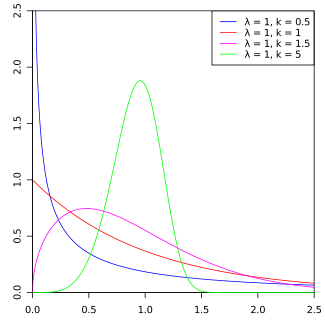Continuous probability distribution
Weibull (2-parameter)|
Probability density function  |
|
Cumulative distribution function  |
| Parameters |
 scale scale
 shape shape |
|---|
| Support |
 |
|---|
| PDF |
 |
|---|
| CDF |
 |
|---|
| Quantile |
 |
|---|
| Mean |
 |
|---|
| Median |
 |
|---|
| Mode |
 |
|---|
| Variance |
![{\displaystyle \lambda ^{2}\left[\Gamma \left(1+{\frac {2}{k}}\right)-\left(\Gamma \left(1+{\frac {1}{k}}\right)\right)^{2}\right]\,}](https://wikimedia.org/api/rest_v1/media/math/render/svg/55fa6b5cdbe81bb9e6aa0452a2c619623cb23f14) |
|---|
| Skewness |
 |
|---|
| Excess kurtosis |
(see text) |
|---|
| Entropy |
 |
|---|
| MGF |
 |
|---|
| CF |
 |
|---|
| Kullback–Leibler divergence |
see below |
|---|
In probability theory and statistics, the Weibull distribution is a continuous probability distribution. It models a broad range of random variables, largely in the nature of a time to failure or time between events. Examples are maximum one-day rainfalls and the time a user spends on a web page.
The distribution is named after Swedish mathematician Waloddi Weibull, who described it in detail in 1939,[1] although it was first identified by René Maurice Fréchet and first applied by Rosin & Rammler (1933) to describe a particle size distribution.
- ^ Bowers, et. al. (1997) Actuarial Mathematics, 2nd ed. Society of Actuaries.












![{\displaystyle \lambda ^{2}\left[\Gamma \left(1+{\frac {2}{k}}\right)-\left(\Gamma \left(1+{\frac {1}{k}}\right)\right)^{2}\right]\,}](https://wikimedia.org/api/rest_v1/media/math/render/svg/55fa6b5cdbe81bb9e6aa0452a2c619623cb23f14)



